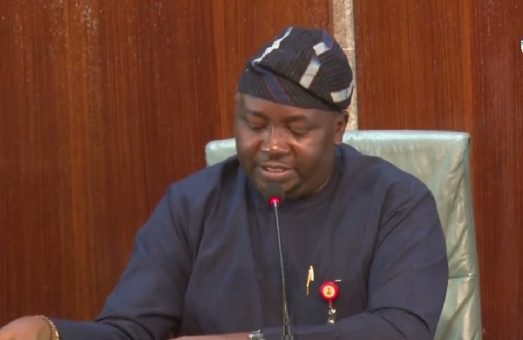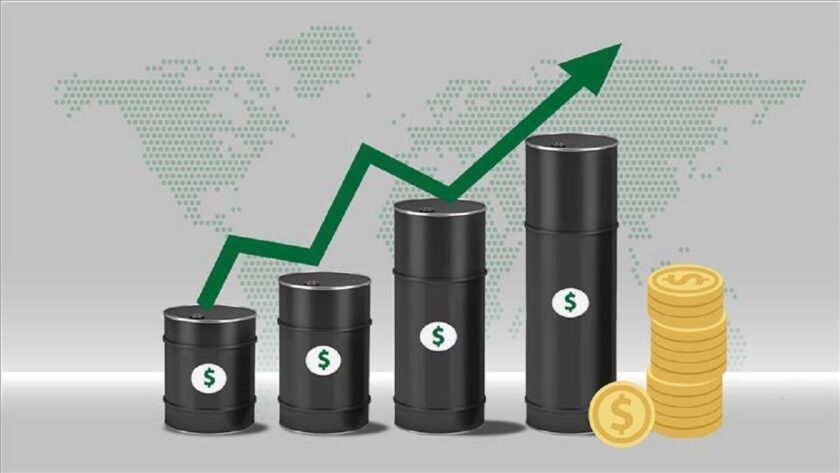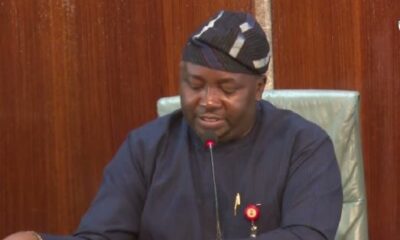Energy
NUPRC: We have reactivated dormant fields

The Nigerian Upstream Petroleum Regulatory Commission (NUPRC) said it reactivated dormant fields, fast-tracking regulatory approvals and enhancing operational efficiencies across the upstream value chain to ramp up production, especially to attain its project one million barrels initiative launched in 2024.
The Commission Chief Executive (CCE), Gbenga Komolafe, who made the remark during the maiden conference of the Energy Correspondents Association of Nigeria (ECAN) yesterday in Abuja, said with a clear target of increasing production to 2.5 million bpd by 2026, the initiative has already demonstrated strong momentum with current unreconciled daily production averaging 1.7 – 1.83 million bpd.
He said there are new frontier opportunities in onshore, shallow water, and deep offshore blocks, especially in underexplored basins, enabled by its new licensing rounds regime.
His words: “There are also other vast and compelling transformative opportunities, particularly in natural gas development, gas-to-power initiatives, Liquefied Natural Gas (LNG) projects, FLNGs and Compressed Natural Gas (CNG) transportation infrastructure, aimed at enhancing both export capacity and domestic energy supply.”
He said the commission has given approval of 37 new evacuation routes, coupled with intensified collaboration with national security agencies, has significantly curtailed crude theft and enhanced accountability across the industry.
“At the same time, the enforcement of the Domestic Crude Supply Obligation (DCSO) is securing consistent feedstock to local refineries, strengthening Nigeria’s internal supply chains, and building long-term economic resilience. On the socio-developmental front, the Host Community Development Trust (HCDT) framework, fully operational via our HostComply digital platform, has created unprecedented transparency and direct community impact, fostering trust, reducing conflict, and reinforcing social licence to operate. Our broader digital transformation agenda is also reshaping regulatory engagement: streamlining approvals, improving investor clarity, and delivering faster and smarter oversight.”
He stated that while hydrocarbons continue to generate nearly 90% of Nigeria’s foreign exchange earnings and 70% of government revenue, he said its long-term viability of the energy sector depends on aligning growth with climate responsibility.
“Our gas-centric energy transition strategy is a cornerstone of this effort, anchored by flagship initiatives such as the Decade of Gas, the Nigerian Gas Flare Commercialisation Programme (NGFCP), and the Presidential CNG Initiative. These programmes collectively aim to eliminate routine gas flaring by 2030 and reduce methane emissions by 60% by 2031.”
“In parallel, we are working collaboratively with industry stakeholders to fully monetize Nigeria’s abundant gas resources through strategic LNG expansion, deployment of floating production solutions, and the development of cross-border pipelines designed not only to power Nigeria’s economy but to accelerate Africa’s broader industrialisation. Beyond infrastructure, the NUPRC is also championing the creation of a transparent, competitive, and investor-friendly gas market, unlocking the commercial potential of an estimated 600+ trillion cubic feet of gas resources (upward potential) and positioning Nigeria as a central hub in the global energy transition.”
The net-zero ambition is also anchored on Nigeria’s Upstream Decarbonisation Framework and Blueprint, designed by the Commission to integrate emissions monitoring, MRV systems, carbon capture and storage, and access to climate finance via carbon markets. In doing so, we are enabling emissions reduction to generate value through a burgeoning carbon services ecosystem: comprising monitoring technologies, advisory services, and advanced deployment tools, while upholding the highest standards of environmental and asset integrity.
The chairman of ECAN, John Ofikhenua, said the theme of the conference: ‘Four Years of the Petroleum Industry Act (PIA): Achievements, Gaps and the Way Ahead,’ is both timely and thought-provoking.
“Four years on, it is right that we pause to ask: How far have we come? What has changed? And what must we still do to make the promise of the PIA a living reality for all Nigerians? As one who has covered this sector for many years, I cannot forget the long and torturous journey that brought us here. For over two decades, we reported the hopes, frustrations, and sheer resilience of stakeholders who yearned for reform. We chronicled the endless back-and-forth of the Petroleum Industry Bill — its drafts, its withdrawals, its controversies, and its rebirth as the PIA.”
He said the passage of the Act was no accident but a triumph of persistence — a product of the vision and hard work of men and women like the late Dr. Rilwanu Lukman, Dr. Emmanuel Egbogah, and many others who laboured behind the scenes from the days of the Oil and Gas Sector Reform Implementation Committee.
“Those of us who were there remember the uncertainty that once defined the sector — when decisions were made by discretion rather than law; when even ministers lamented that their hands were tied. We remember how former Petroleum Minister, Odein Ajumogobia, eager to deliver results, was accused of jumping ahead of legislation — a reflection of just how paralyzed the system had become. And who among us can forget those long, frustrating queues at filling stations — symbols of a broken framework and an outdated policy regime?”
On his part, the Minister of Petroleum Gas said the event is both timely and commendable, as it also provides an essential platform to reflect on the progress made since the enactment of the Petroleum Industry Act four years ago.
“The PIA remains a landmark legislation that has redefined the governance, fiscal, and operational frameworks of Nigeria’s oil and gas industry.”
Energy
8,500 transmission capacity: Low demand stalls generation of 3,500MW

• Nigeria conducts grid synchronisation test connecting 15 countries for four hours
The Ministry of Power yesterday said despite the availability of 8,500MW transmission capacity in the Nigerian Electricity Supply Industry (NESI), low demand from the Distribution Companies (DisCos) has limited generation to 5,000MW, stalling 3,500MW.
As of July 17, 2025, the wheeling capacity was 5,500MW.
But the ministry disclosed its recent wheeling capacity in Abuja during a media briefing where it announced that Nigeria successfully conducted a grid synchronization test with 15 West African countries for four hours on November 8, 2025.
“Today, the minimum grid capacity we can even communicate is 8,500MW of capacity. If our generation reaches 8,000 MW today, the grid can comfortably and conveniently transmit it,” Adelabu said.
Besides, the Nigerian Independent System Operator (NISO), Market Operation Executive Director, Dr. Edmund Eje, explained that since electricity cannot be stored, the industry only generates energy based on demand.
His words: “The amount of energy generated is equal to the amount of energy that will be transmitted, and it is also equal to the amount of energy that is demanded by the distribution companies. It is simultaneously consumed.
“You don’t stall energy anywhere. The transmission capacity can carry 8,500MW, but it can only carry what can be consumed. Generators will not generate more than what will be consumed at the same time.”
On synchronization, he said the feat of successful synchronization will not affect the allocation of energy for domestic consumption.
Eje said that although there is a regulation that Nigeria allocates 600MW for bilateral trade, production constraints presently limit it to 360MW.
Adelabu, however, described the synchronization test success as a step towards the elimination of grid collapse from the industry, noting it means that there is confidence that the system is now resilient.
He described it as a landmark development in the evolution of West Africa’s electricity architecture.
He confirmed that on 8th November 2025, Nigeria successfully conducted a grid synchronisation test connecting the national electricity grid with the interconnected West African Power Pool (WAPP) system.
According to him, the exercise represents the first time in history that Nigeria has operated in a unified, stable, and fully harmonised configuration with the rest of the sub-region.
He clarified that while it is not yet a permanent synchronisation, the successful test clearly demonstrates that regional technical alignment is feasible and marks a major step toward eventual full integration.
Adelabu further noted that the synchronisation exercise, conducted between 05:04 a.m. and 09:04 a.m., involved the Nigerian grid which includes Niger Republic and parts of Benin and Togo and the rest of West Africa’s interconnected systems covering Ghana, Côte d’Ivoire, Burkina Faso, Liberia, Sierra Leone, Guinea, Senegal, The Gambia, Guinea Bissau, and Mali.
He said for four uninterrupted hours, power flowed seamlessly across national borders, operating at a single stable frequency and proving that West Africa is now technically capable of functioning as a unified power bloc.
He said the achievement ranks among the most significant milestones in the history of WAPP.
He said the test marks the first successful large-scale synchronisation attempt since 2007, when a short-lived trial lasted only seven minutes before failing.
Adelabu said Nigeria has made history with the successful synchronization of the national grid with the West African Power Pool interconnected system.
For four unbroken hours, according to him, electricity flowed from Nigeria and Niger into the entire West African sub-region covering Benin, Togo, Ghana, Côte d’Ivoire, Liberia, Sierra Leone, Guinea, Senegal, Mali, The Gambia, and Guinea-Bissau operating at a single, stabilized frequency.
Earlier at the NISO Maiden Stakeholders’ Engagement, the Managing Director, Engr. Abdul Mohammed said the milestone recorded with the synchronization milestone is more than a technical success, since it positions Nigeria as a regional power hub; opens new avenues for electricity trading; unlocks foreign exchange potential; and reinforces investor confidence in the emerging Nigerian electricity market.
According to him, a resilient electricity market requires more than engineering; it requires relationships.
He said it requires trust among service providers, trust between the market and regulators, trust between the government and operators, and, above all, trust from the Nigerian people.
Energy
Brent rises 1.32% to $65 as drone strike halts 260,000bpd Russian refinery

By Grace Edet
Crude oil prices edged higher on Tuesday after a Ukrainian drone strike knocked out one of Russia’s largest refineries, disrupting 260,000 barrels per day (bpd) of processing capacity and raising fresh concerns over global supply stability as winter demand builds.
Brent crude was up 1.32 per cent at $65.05 per barrel at 9:00 WAT, with analysts warning that the outage could trigger further price increases in the coming days.
The Ryazan refinery, Russia’s fourth-largest and operated by Rosneft, has now been hit twice in less than a month as Ukraine escalates its long-range strike campaign. The latest attack halted the plant’s main crude distillation unit, which accounts for roughly 5 per y of Russia’s total refining capacity.
Industry sources told reporters that the refinery will remain shut until at least December 1, adding that “no product deliveries are expected before then,” while several secondary units have also been idled.
Prices Mixed Across the Energy Market
While Brent gained, WTI held steady at $60.90 per barrel, showing no change. Murban crude ticked up by 1.06 per cent to $66.46, whereas natural gas slipped 0.16 per cent to $4.368. Analysts say the muted price response masks rising anxiety beneath the surface.
“Market sentiment has turned cautious. If these outages persist or Moscow’s infrastructure comes under renewed fire, the supply picture could tighten very quickly,” an energy expert, Mustapha Shuaid said.
Winter Demand Meets Heightened Geopolitical Risk
The attack comes at a sensitive period, with temperatures dropping across Europe and Asia. Energy markets typically enter a high-demand phase from late November, making geopolitical disruptions more consequential.
Ukraine’s strategy has increasingly shifted toward high-impact targets. According to the Centre for European Policy Analysis, Kyiv is now focusing on “high-value refinery equipment like cracking units — assets that are harder to replace and more disruptive when damaged.”
Recent strikes have also hit terminals and export routes, including the strategic Novorossiysk port on the Black Sea.
Market Braces for Upside Risk
Although front-month prices remain relatively stable, traders say the underlying risk of a significant price upturn is rising. The outage at Ryazan, combined with the threat of additional strikes, could squeeze Russian product exports and rattle global supply chains.
“The next few weeks will be pivotal. Any escalation could be enough to disrupt balances and trigger a price rally, with spillover inflation risks for energy-dependent economies,” another analyst, Akin Owolabi told TheTrustNews.com.
With the Ryazan plant offline and Russia’s refining network increasingly exposed, the oil market enters the winter season on a fragile footing.
Energy
Diesel falls to ₦979/L in Lagos

By Grace Edet
Diesel prices in Lagos have dropped below ₦1,000 per litre for the first time in months, offering rare relief to transport operators, manufacturers and SMEs.
Market checks on Tuesday showed rates as low as ₦979 per litre at Mobil Idowu Egba, ₦980 at NNPC Retail Igando and ₦995 at Petrocam Isheri, driven by stronger domestic supply and heightened competition among retailers.
But fresh cost indicators suggest the drop may be short-lived. New data from the Major Energy Marketers Association of Nigeria (MEMAN) shows diesel landing cost has climbed to ₦980.28 per litre, signalling pressure on retailers and raising the likelihood of a price rebound.
According to market analysts, the rising landing cost is being driven by firmer international prices, higher cargo premiums and renewed bulk purchases by major distributors seeking to replenish stock.
They warn that the current sub-₦1,000 pump prices do not reflect the cost realities facing importers.
Foreign exchange volatility is compounding the pressure. The naira traded between ₦1,430 and ₦1,450 to the dollar over the past week, creating uncertainty for fuel traders and affecting forward pricing.
New coastal pricing formulas tied to Platts benchmarks are also shaping expectations for higher replacement costs.
Analysts note that Dangote Refinery’s lack of any announced price reduction is another sign that the current relief may not last. Market behaviour suggests wholesalers may soon begin building inventories in anticipation of upward adjustments.
“Diesel may have dipped below ₦1,000, but all cost indicators point to a likely rebound. Rising landing costs and FX pressure will inevitably filter through the supply chain,” a Godfrey Olatunde, a Lagos-based energy analyst told TheTrustNews.com.
With cost drivers now trending upward, stakeholders warn that the modest price drop recorded this week may be temporary as the market prepares for another adjustment.
-

 Art & Life8 years ago
Art & Life8 years agoThese ’90s fashion trends are making a comeback in 2017
-

 Entertainment8 years ago
Entertainment8 years agoThe final 6 ‘Game of Thrones’ episodes might feel like a full season
-

 Art & Life8 years ago
Art & Life8 years agoAccording to Dior Couture, this taboo fashion accessory is back
-

 Entertainment8 years ago
Entertainment8 years agoThe old and New Edition cast comes together to perform
-

 Sports8 years ago
Sports8 years agoPhillies’ Aaron Altherr makes mind-boggling barehanded play
-

 Entertainment8 years ago
Entertainment8 years agoMod turns ‘Counter-Strike’ into a ‘Tekken’ clone with fighting chickens
-

 Entertainment8 years ago
Entertainment8 years agoDisney’s live-action Aladdin finally finds its stars
-

 Business8 years ago
Business8 years agoThe 9 worst mistakes you can ever make at work














